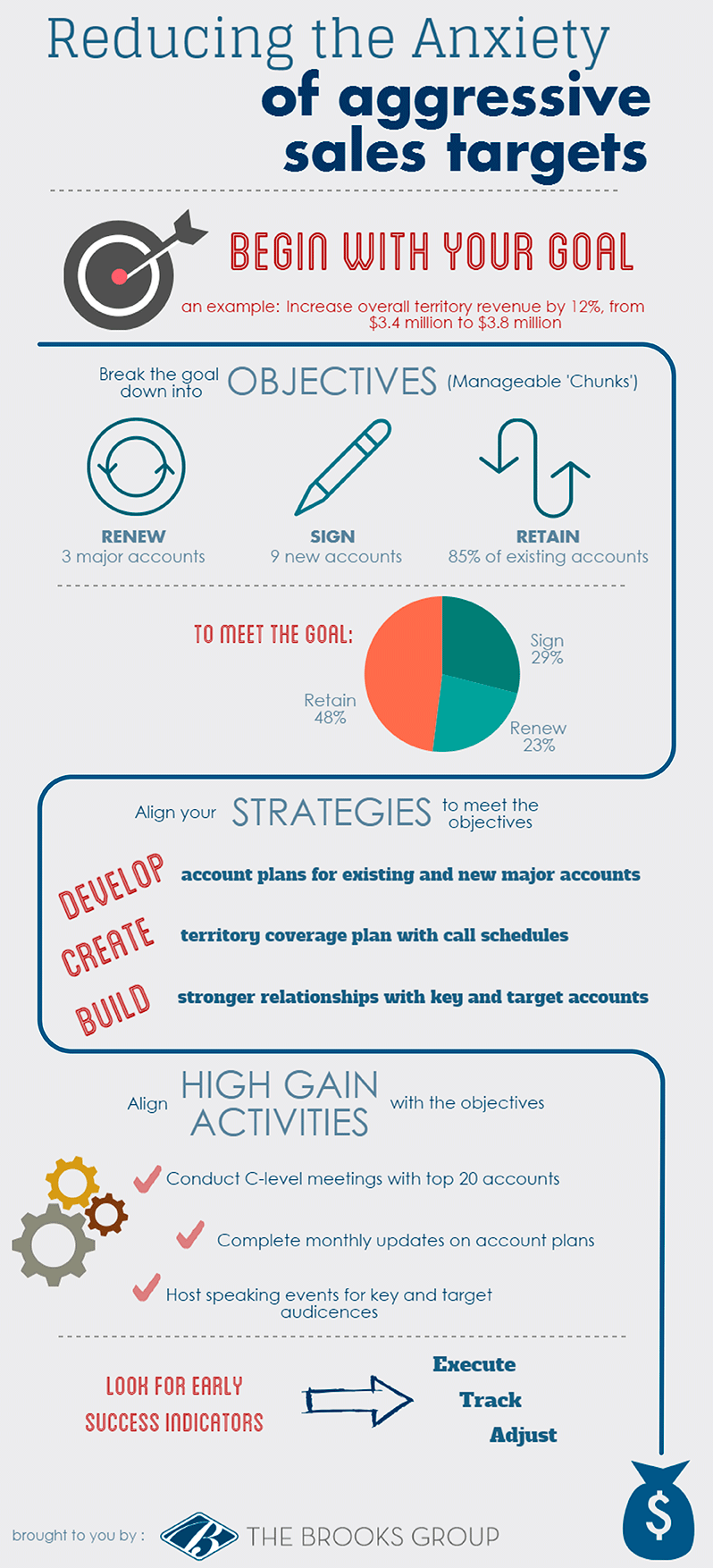You Want Me to Sell How Much?
Getting buy-in from your sales team for an aggressive target isn’t about selling an idea to them, but rather leading them through an executable plan for achieving it. If you want your salespeople to face a challenging sales goal with confidence and momentum, you have to change their perspective on it.
Here’s how to do that:
Step 1: Chunk It – Break Down Intimidating Sales Goals into Manageable ‘Chunks’
Driving to Niagara Falls from North Carolina is a long drive (especially with a dog and two teenagers) and when first seeing the numbers…10 hours – 652 miles, you start to sweat. But, once you chart your milestones, Starbucks in Beckley, Lunch in Clarksburg, ice cream in Pittsburgh, another Starbucks in Erie, etc., it becomes less intimidating. Chunking it makes it easier to digest (along with all the snacks along the way).
When breaking down an aggressive sales target, first chunk it into two parts. Existing accounts and new accounts. Then break it down further – percentage of existing account sales that would likely come with little to no sales attention and the percentage of existing account sales that will require some heavier lifting. Then break down the new accounts into the percentage of new accounts with active opportunities today and the percentage of new accounts with no current opportunities. Chunked even further…what percentage of new accounts with no current opportunities will originate from marketing leads and/or old accounts and/or referral accounts and/or channel partners, etc.
For example, that $5,500,000 sales target broken down could look like this:
$3,500,000 Existing Maintenance Accounts
$500,000 New Product Sales from Existing Accounts
$350,000 New Accounts from Channel Partners
$300,000 New Accounts with Existing Opportunities
$250,000 Brand New Accounts from Marketing Leads
$500,000 New Opportunities from Old Accounts
$100,000 Brand New Accounts from Your Strategic Prospecting Prowess
The once daunting figure becomes less intimidating and reps feel a sense of, “alright, I can do that.”
Step 2: Create the Strategies and High Gain Activities to Meet Chunks (Achievable Objectives)
Once your salespeople see that scary target is actually quite doable, you can apply an average sale value to these numbers and identify the number of new ‘sales’ or ‘deals’ they need to close. Depending on the average length of your sales cycle and your win rates (conversion rates or close rates), you can then determine how many new, qualified opportunities will be required for each ‘chunk’.
This is where most sales leaders STOP.
But not you…from there, it’s time to create your actionable strategies for each of these now achievable objectives. Involve your salespeople in determining specific strategies that are executable through measurable high gain activities.
For example, to achieve $500,000 (this fiscal year) from new opportunities from old accounts, the salesperson will need to generate six qualified opportunities before Q3. One strategy could be to improve your positioning within these accounts by offering educational ‘lunch and learns’ to their engineering teams. A high gain activity: conduct two ‘lunch and learns’ per month for the next 6 months. This is specific, measurable, and actionable.
With high gain activities in place, we can now support and enable their execution. Without them, you have an impressive territory plan and a frustrated salesperson, but that’s it.
Step 3: Find “It’s working” Evidence and Celebrate the Progress
It’s not uncommon for sellers to reach a mental plateau, but you can help rebuild momentum by showing them that the small steps they are taking are resulting in progress. Highlighting these ‘small wins’ as early as possible boosts confidence in the plan and themselves. It will build momentum and keep them focused on those critical activities.
Remember just how impatient sale people can be. If they don’t see early payback for their efforts, they will revert back to older, less effective habits.
A Word on Excuses
It is very common for salespeople to provide endless excuses as to why they can’t achieve these aggressive sales targets. Acknowledge their concerns, but only if they are valid. Remind them that every company has challenges that become obstacles in achieving sales targets. Everyone has service problems, billing issues, and delivery nightmares. Ensure the focus remains on what we can do and not on what we cannot do.
So, while we continually look to remove obstacles and enable our team, it’s important for us to remember that our job as a sales leader is to lead our team to success in spite of all of those challenges.





